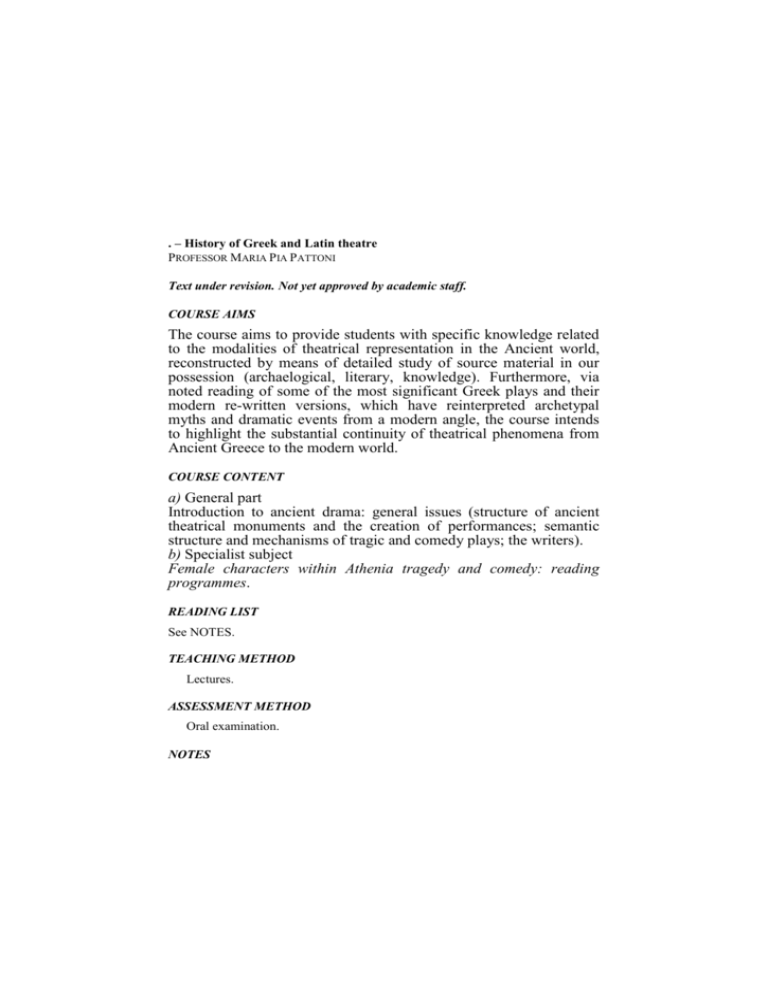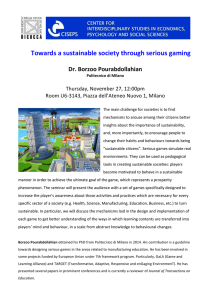History of Greek and Latin theatre
advertisement

. – History of Greek and Latin theatre PROFESSOR MARIA PIA PATTONI Text under revision. Not yet approved by academic staff. COURSE AIMS The course aims to provide students with specific knowledge related to the modalities of theatrical representation in the Ancient world, reconstructed by means of detailed study of source material in our possession (archaelogical, literary, knowledge). Furthermore, via noted reading of some of the most significant Greek plays and their modern re-written versions, which have reinterpreted archetypal myths and dramatic events from a modern angle, the course intends to highlight the substantial continuity of theatrical phenomena from Ancient Greece to the modern world. COURSE CONTENT a) General part Introduction to ancient drama: general issues (structure of ancient theatrical monuments and the creation of performances; semantic structure and mechanisms of tragic and comedy plays; the writers). b) Specialist subject Female characters within Athenia tragedy and comedy: reading programmes. READING LIST See NOTES. TEACHING METHOD Lectures. ASSESSMENT METHOD Oral examination. NOTES Further information can be found on the professor's webpage at http://www2.unicatt.it/unicattolica/docenti/index.html or on the Faculty notice board 1) the course will take place during the first term (October-December). 2) Programme for full-time students and the relative reading list: a) lecture notes; photopies for students will be available from the Photocopy Office at the beginning of the course; critical essays and predominantly iconographic material online (it can be downloaded from the tutor’s webpage); b) Il teatro greco. Tragedie, with an introductory essay edited by G. Paduano, BUR, Rizzoli, Milano 20061; Il teatro greco. Commedie, with an introductory essay edited by G. Paduano, BUR, Rizzoli, Milano 20071 (the examination programme will include the selection of tragedies and commedies read and discussed during lectures, the list will be posted on the tutor’s webpage at the end of the course). c) Home reading: from Il teatro greco. Tragedie, with an introductory essay edited by G. Paduano, BUR, Rizzoli, Milano 20061: Eschilo, Orestea; Sofocle, Trachinie, Edipo re, Edipo a Colono; Euripide, Ippolito, Ifigenia in Aulide, Ifigenia in Tauride, Troiane, Baccanti; from Il teatro greco. Commedie, with an introductory essay edited by G. Paduano, BUR, Rizzoli, Milano 20071: Aristofane, Lisistrata, Le donne all'assemblea, Le donne alle Tesmoforiazuse, Nuvole, Rane. d) One of the following programmes (students from the Workshop on Ancient Dramaturgy run by Professor C. Cuccoro do not need to bring this part of the programme to the examination): I) programme on modern revisitations of Ancient tragic myths: (an in-depth look at theatre by Sophocles): SOPHOCLES, ANOUILH, BRECHT. ANTIGONE. Variazioni sul mito, edited by M.G. Ciani, Marsilio, Venezia (various reprints); ANTÓNIO SÉRGIO DE SOUSA, Antigone, translation by C. Cuccoro, with an introductory essay edited by M.P. Pattoni, Educatt, Milano 2014 (new edition). II) programme on modern revisitations of ancient tragic myths (an in-depth look at theatre by Euripides): EURIPIDES-WIELAND-RILKE-YOURCENAR-RABONI, Alcesti. Variazioni sul mito, ed. Marsilio, Venezia, 2006; M.P. Pattoni - R. Carpani (edited by), Sacrifici al femminile: Alcesti in scena da Euripide a Raboni, Vita e Pensiero, Milano (Comunicazioni sociali 26.3), pages 488-558 (this book is on sale at the Libreria dell'Università Cattolica, in Via Trieste). III) Reading of any play from those covered during the course (in Greek), to be arranged with the tutor (also concerning the edition). 3)Regular attendance is recommended. Students with serious reasons for not being able to attend lectures should contact the tutor by the end of the course so as to arrange an alternative study programme. 4) Students may see Professor M.P. Pattoni in his office (Second Floor, East Wing) on lecture days. The timetable will be posted online on the tutor’s webpage as well as on the tutor’s notice board in his office; any chnages will be indicated on the tutor’s webpage.






